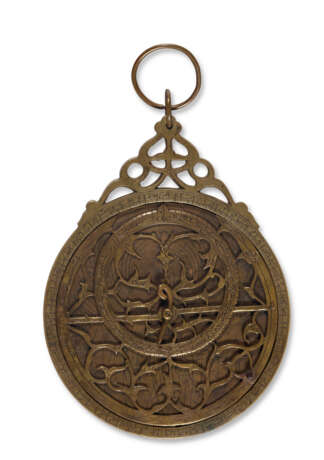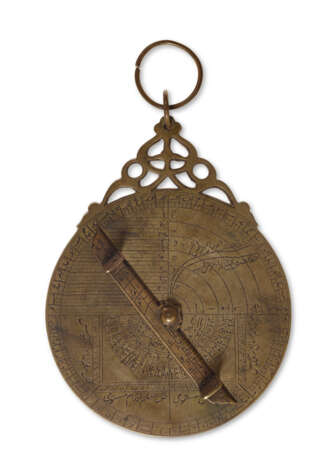ID 1360779
Lot 63 | A BRASS ASTROLABE
Estimate value
$ 4 000 – 6 000
Planispheric astrolabes were generally used for charting astrological bodies, finding the direction of the qibla, and determining the times of prayer. The astrolabe’s origin probably dates at least as far back as the ancient Greek astronomer Hipparchus (c.190–120 B.C.). As with so much astronomy, through the traditions of medieval Islamic science it was reintroduced to the Latin West by the thirteenth century, where it became a key time-telling instrument. Their production in Europe reached its zenith in the late Renaissance when they were made for princely collections and came to be the iconic instrument of astronomical knowledge.
A brass plate (the rete) carries hooked pointers for named stars and acts as a rotating celestial map above a grid that shows the lines of altitude and azimuth in the night sky; the owner of the astrolabe would be able to change the plate carrying the grid depending on how far North or South they were—the mapping of the night sky onto a flat disc is done via a stereographic projection. The reverse of the astrolabe carries a compendium of different projections, a sundial and grid for trigonometry calculations, a calendar and a shadow square that can be used to measure the heights of buildings. Around the back plate rotates an alidade with pinhole sights that are used to observe the height of the Sun or a given star (the taking of a star's position gives the ancient Greek etymology astro-labos, “star-taker”).
The inscription on the back of the astrolabe gives the date of manufacture as AH 1073/1662-3 AD and attributes it to the hand of the great Mughal instrument maker, Diya' al-Din Muhammad ibn Qa'im al-Lahuri, who is given the epithet al-Astrolabi in recognition of his skill. Examples of his work include two astrolabes in the Museum of the History of Science in Oxford dated to 1653-34 (acc.no.38862) and 1658-59 (acc.no.53637). Based on stylistic features, we believe this not to be his work but instead that of a later craftsman, possibly with access to photographs of original examples. Such pieces were popular souvenirs for travelers visiting India and Iran; a particularly fine example of an astrolabe with inscriptions in devanagari was presented to the Prince of Wales by the Maharaja of Jaipur around 1875, and is now in the Royal Collection (acc.no.RCIN 11209).
143mm high overall; 110mm diameter
| Address of auction |
CHRISTIE'S 20 Rockefeller Plaza 10020 New York USA | ||||||||||||||
|---|---|---|---|---|---|---|---|---|---|---|---|---|---|---|---|
| Preview |
| ||||||||||||||
| Phone | +1 212 636 2000 | ||||||||||||||
| Fax | +1 212 636 4930 | ||||||||||||||
| Conditions of purchase | Conditions of purchase | ||||||||||||||
| Shipping |
Postal service Courier service pickup by yourself | ||||||||||||||
| Payment methods |
Wire Transfer | ||||||||||||||
| Business hours | Business hours
|




